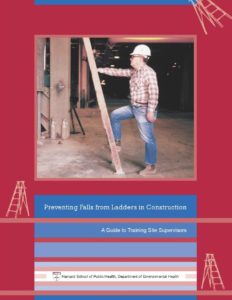Ladder Falls NEISS Follow-back (Completed – 2004-2009)
Melissa Perry, ScD
The George Washington University School of Public Health and Health Services
Washington, DC
Ph: 202-994-1734
[email protected]
The construction industry experiences the largest number of deaths from ladder falls among U.S. industries, accounting for 52 percent of such deaths in the period 1981-2003. Dr. Perry and her research team aimed to curb this trend, First identi-fying the circumstances leading to ladder falls and then developing a tool for assess-ing ladder fall hazards on worksites. The team’s ultimate goal is to develop targeted ladder fall prevention strategies.
According to an initial evaluation of data from several large occupational surveys, the researchers found that 51 per-cent of fall injuries occurred on step or trestle ladders and 40 percent on exten-sion ladders. In one-quarter of the cases, the ladder slipped out at the base or bot-tom, and in another 20 percent the worker lost balance for another reason. Among identifiable underlying causes, improper ladder setup was most common, accounting for 18.2 percent of cases.
The team developed a hand-held digital tool to measure worksite compliance with ladder use best practices. The tool contained checklists in four categories: ladder condition, setup, moving on a ladder, and completing tasks from a ladder. The tool was used to conduct assessments at 18 worksites, yielding observations of 1,151 pieces of equipment used to reach heights (stepladders, extension ladders, lifts, etc.). The sites were found to have stepladders of good quality and their set-ups regularly had spreaders locked. However, compliance with some best practices was lacking, such as having hands free while climbing (46 percent compliance). The researchers concluded that the tool offers a practical method to quantify best practices associated with ladder use that can ultimately inform targeted intervention efforts.
Research Team: Jack Dennerlein, PhD, and Christopher Ronk, MS, Harvard University; David Lombardi, PhD, Jaeyoung Kim, MS, Liberty Mutual Research Institute; Partner: Tom Schroeder, U.S. Consumer Product Safety Commission.
Original Project Abstract:
This project seeks to prevent falls from ladders in construction by translating data on epidemiologic risk factors and field assessment hazards into applied preventive interventions. Despite the considerable attention to fall prevention in construction, falls from ladders have received less attention and the most effective intervention approaches are not yet obvious. This project will progress in two stages focusing on pre-intervention studies to determine modifiable risk factors and then their subsequent translation into intervention programs. The pre-intervention research stage will investigate three specific aims: 1) identifying the actual circumstances involved in falls in constructions from portable ladders using a combination of descriptive coded narrative text data from national surveillance data systems; 2) quantifying the highest risk tasks and other modifiable risk factors for worker falls from ladders using unique case-crossover methods in which injured workers serve as their own controls; and 3) developing audit tools for on-site assessments of the portable ladder practices, including modifying available straight ladder checklists to step ladders. The subsequent implementation stage will focus on two additional specific aims: 4) critically reviewing the efficacy of available risk reduction training approaches and ladder design variations; and 5) testing multifaceted interventions and measuring effects using an experimental study design. The intervention will focus on targets to reduce risk such as ladder design, job task design, and managerial safety training approaches. Intervention programming will use methods such as worksite audits and jobsite superintendent training to communicate risk reduction information. The intervention messages will include ways to incorporate 10-point safety checklists into work routines to reduce worksite ladder hazards and substituting other equipment for the most hazardous tasks done on ladders. A randomized controlled design that includes cluster randomization and analysis will be used to test intervention effectiveness. Hypotheses to be tested include the efficacy of the intervention on reducing ladder hazards and increasing.
